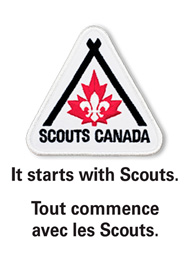Heard it from a Scout: Winter camping tips for beginners
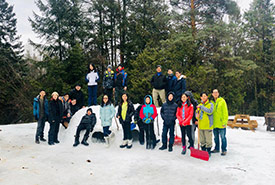
Building a quinzhee (Photo by Scouts Canada)
With winter’s temperatures and snow, camping can be tricky. But with a little preparation, you can discover that winter camping can be some of the most fun and unforgettable experiences you can have. Check out our top tips to help make your winter camping adventure a success!
Related content
1. Starting a fire
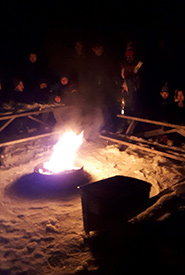
Enjoying a campfire (Photo by Scouts Canada)
No camp is complete without a campfire! But with freezing temperatures and moisture everywhere, starting one can be a challenge. There are ways to guarantee success.
Come prepared with fire starter, such as matches, flints or lighters, lots of tinder and your own dry kindling. It will take much longer for the fire to spread if your wood is wet, especially if you collect it from the forest. Before laying down your firewood, shovel out the snow around your campfire pit to keep your firewood from collapsing when the snow melts. To make sure your campfire can withstand the wind, stack your wood log-house style. The four square walls of the “log house” will protect your flames, allowing your fire to get stronger faster.
2. Sleeping warm
When you think about winter camping or winter outdoor adventures, you might be thinking about a fun day outside and then staying in a cozy cabin at night. But sleeping outside in a tent or a quinzhee (see below for more info) are great ways to spend your nights. The thought of being cold
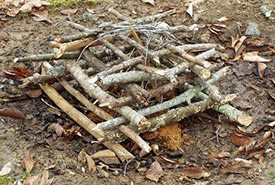
Starting a fire using log-house-style branches (Phot by Scouts Canada)
may intimidate you at first, but with our detailed packing list below, you’ll find sleeping outside in the winter isn’t so bad.
- Bring an appropriate-temperature-related sleeping bag. You can find its rating on the packaging. In Canada, you’ll want a sleeping bag rated for at least -20 C.
- Use a fleece sleeping bag liner. It will help boost the temperature rating of your sleeping bag slightly, and you don’t have to clean your sleeping bag as often — just the liner!
- Use a closed-cell foam sleeping pad under your inflatable foam sleeping pad to ensure better insulation between you and the ground.
- Tuck handwarmers or a hot water bottle into your sleeping bag for extra warmth during the coldest hours of the night.
3. Building a quinzhee
In my experience, you haven’t had the full winter camping experience if you haven’t built or at least tried to build a quinzhee. I have tried it myself many times and sometimes there simply isn’t enough snow to do so, and it melts. But when you succeed and sleep inside one, you will never forget the experience.
- First, shovel a pile of snow into a mound that measures two to two-and-a-half metres high and is big enough to hold two people once it’s hollowed out.
- Next, shape it into a dome and wait for the pile of snow to settle and harden. This will take around 90 minutes, but may take longer depending on the temperature and wind conditions. Find long branches about a centimetre thick and stick them vertically into the mound (around 30 to 60 centimetres deep in the snow) to make sure that the walls aren’t too thin when you hollow them out. The walls should be 30 to 60 centimetres thick.
- Hollow out the quinzhee by digging from one end into the centre until you reach the ends of the branches stuck in the snow. Then, melt the interior walls a little bit using a candle or portable heater so they ice over and strengthen the overall structure.
- After all of this hard work, you need to make a ventilation hole. Using a stick, slowly drill a hole around two to three centimetres in diameter at the top, being careful to not break the roof!
- When building a quinzhee, you want to make sure you stay warm and dry during the hollowing-out process. Snow may get into your boots, up your sleeves and down your back. Take frequent breaks to shake it out before it melts and makes you wet. Stay dry by wearing a face mask, proper snow pants and investing in a pair of gaiters.
Check out this trail card for other useful tips and tricks on building quinzhees.
4. General tips
- Bring extra batteries for electronic devices. Most pieces of equipment lose power faster in the cold. Keep batteries and electronic devices warm by keeping them close to your body, such as in an inside pocket of a jacket.
- Make sure to use a four-season tent. These tents offer more insulation and are designed to withstand snowfall due to the thicker fabric.
- If you leave things outside overnight, cover them with a tarp in case it snows. However, be cautious of wildlife, even in the winter.
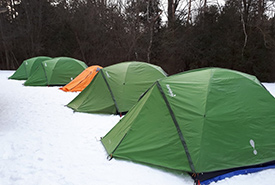
Four-season tents for winter camping (Photo by Scouts Canada)
With proper planning and equipment, you too will see why camping in the winter is fun and unique.
"Heard it from a Scout" is written by members of Scouts Canada’s Youth Spokesperson program. This post was authored by Elkan Fok.

